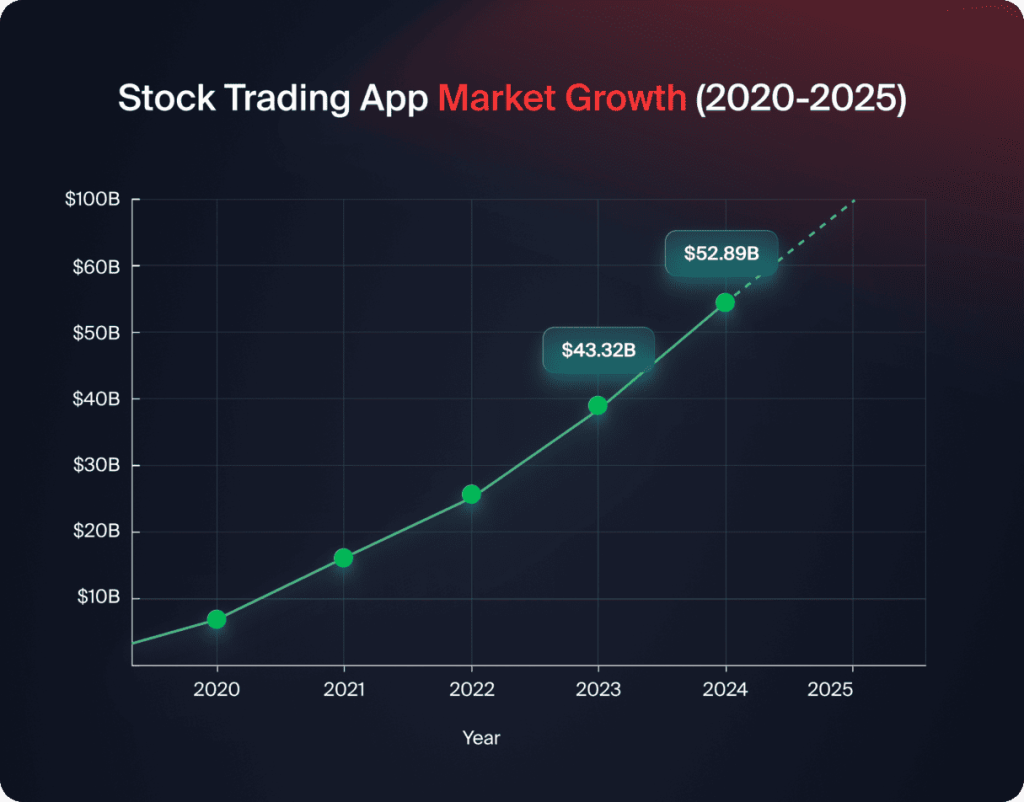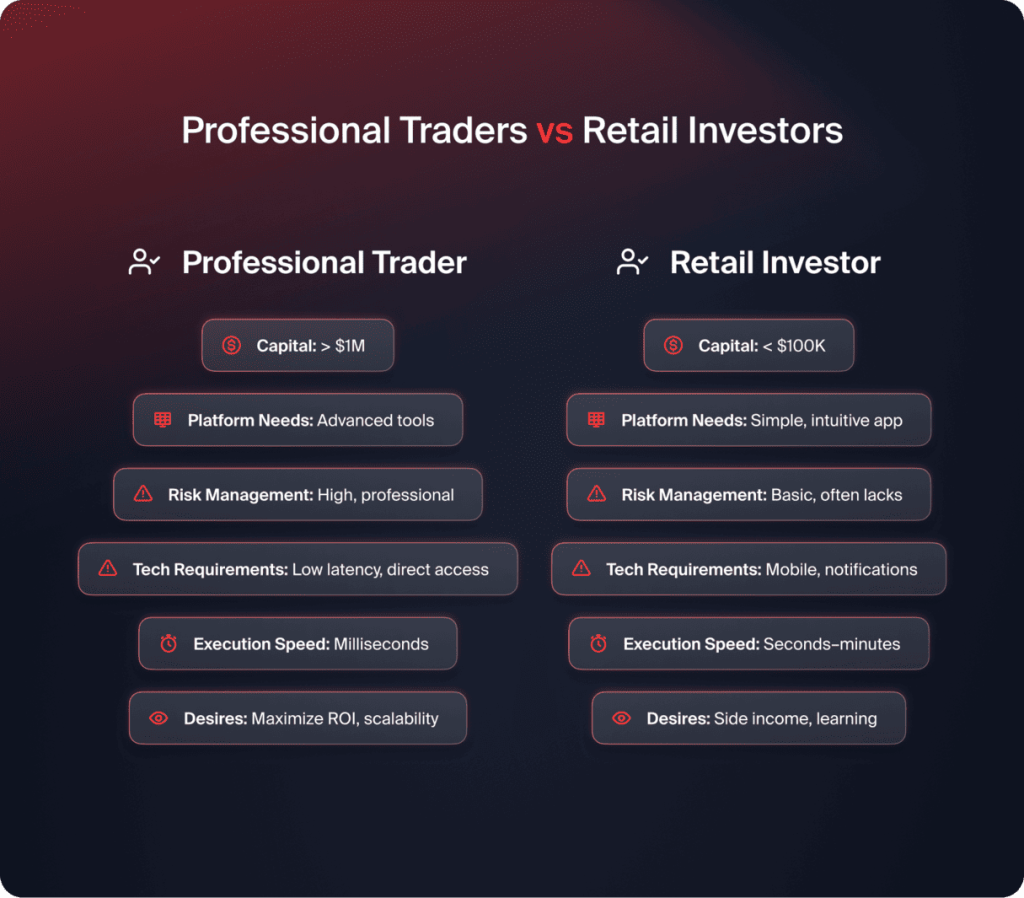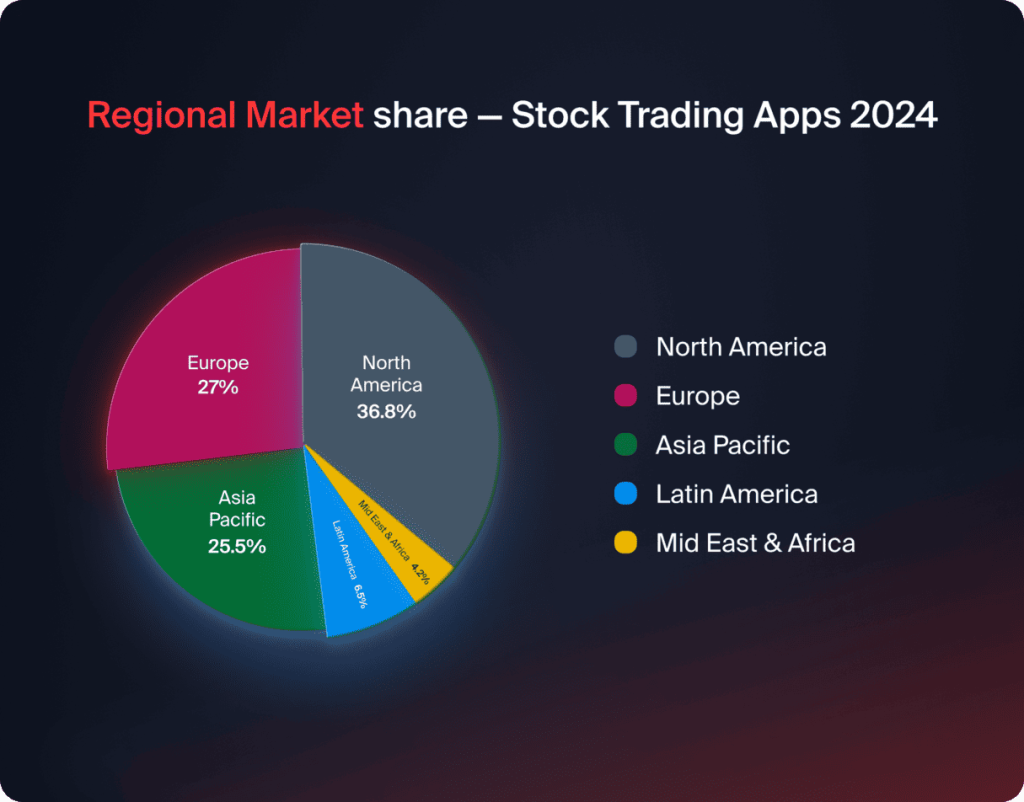
How to Start a Stock Trading App in 2026?
Contents
Starting a stock trading App in 2026 positions you in a fast-growing market, worth approximately $53 billion in 2024 and expected to grow at a Compound Annual Growth Rate (CAGR) of 18% to 20% between 2029. With mobile trading becoming the standard and millions of new investors joining daily, now is the perfect time to launch your platform.
Here’s a quick roadmap:
- Research your market and define your niche
- Decide between white-label or custom development
- Build or customize your platform
- Choose your licensing jurisdiction and get the necessary licenses
- Launch and acquire users
Now, let’s take a closer look at all the questions you need to answer and boxes you need to tick to start a stock trading App in 2026 successfully.

How Stock Trading Apps Work
Before starting your own stock trading App, it is crucial that you understand how it works. This is to guide your development approach as to what and what not to include in your App in term of features.
Just like any other trading App, a stock trading App allows users to buy and sell financial instruments (like stocks, bonds, options, futures, or ETFs) through a broker or financial institution. Such Apps also allow users to manage or monitor their positions.
These operations are made possible because the App connects users to brokerage accounts and provides them with the tools needed for market analysis. This way, they are able to access real-time quotes and charts of various financial instruments to make an informed trading decision.
However, to fully have access to all these functionalities, users must open and fund a brokerage account through the App. So, if they initiate an order, the App routes it to exchanges for execution. Therefore, a stock trading app functions as an intermediary by serving as the user interface for a licensed brokerage firm.
Is it Profitable to Run a Stock Trading App?
The stock trading mobile app market experienced revolutionary development, fundamentally changing the manner in which millions of people invest. Mobile apps are the dominant platform for online trading, accounting for a large part of digital transactions presently. This means mobile-first design is no longer an option but a requirement.
There was a 47% year-over-year increase in downloads of trading apps globally, with an estimated 7.3 million new downloads through August 2024. This reflects a tremendous growth in app users worldwide.
Market size of trading and investing in stock apps increased from an estimated $43-$45 billion in 2023 to approximately $53 billion in 2024, with a staggering CAGR of 20.1%.
The market segment of individual investors typically makes up the lion’s share of the app market, a situation that is bound to continue up to 2033 due to the staggering 22.2% CAGR estimated for this category of users.
You may also like

What Drove the Market to This Point?
Below are some of the factors that have contributed significantly to the growth of this market.
- Zero-Commission Trading: Robinhood disrupted the industry in 2013 by eliminating trading fees. This forced competitors like Charles Schwab and E*Trade to follow suit, making investing accessible to millions of price-sensitive users.
- Fractional Share Trading: Expensive stocks like Amazon or Google are now accessible to small investors. Users can start with as little as $5, building diversified portfolios without large capital requirements.
- Mobile-First Generation: Millennials and Gen Z comprise the majority of new investor cohorts. They expect mobile-first engagement with AI-powered features and intuitive interfaces. PC-oriented platforms will lose market share to competitors who deliver excellent smartphone experiences.
- Educational Content Demand: In-app learning materials help novice investors understand market basics before risking money. This increases engagement and retention rates significantly.
These trends create opportunities for new starters who understand user needs and are capable of acting quickly. Therefore, it is profitable to run a stock trading App, provided you can meet your potential clients’ needs.

How Much Does it Cost to Build Your Stock Trading App
Your development approach — white-label or custom solution — impacts your cost, timeline, and competitive advantage. You would find out which one suits your needs the most with the descriptions below.
White Label Solution
White label solutions provide existing trading platforms that are capable of being branded with your own identity. They typically cost between $50,000 – $150,000. You get compliant software with in-built security functionality and regulatory functionality. Typically, white label products are launched in 2-3 months, from license to customization.
The advantages are apparent: faster time to market, lower up-front cost, proven technology, and ongoing support. But you’re constrained by customization, monthly licensing fees, and dependency on the vendor.
Custom Development
Custom development, on the other hand, gives full feature and design control, no licensing fees for reuse, and easy change of direction based on feedback from users. Cost is between $150,000 and $400,000+, and you get to have ownership of the code and can differentiate from competitors.
However, it takes up to 6-12 months for MVPs (minimum viable products) and 12-18+ months for fully featured platforms. Regulatory licensing added takes another 3-6 months, which is jurisdiction-dependent. The cons are greater cost, longer development time, and more technical risk.
If you decide to opt for a white-label solution like Quadcode, we provide you with Mobile Apps for both iOS and Android, as well as a PWA. Many successful platforms usually start with a white-label platform to validate demand and then transition to custom development once profitable. This reduces upfront risk while preserving long-term flexibility.
How to Build Your Stock Trading App: Technical Guide
Once you’ve been able to decide on which option, white-label or custom development, suits your needs and those of your potential clients, you can now proceed to building your trading platform. This can happen in parallel with licensing when possible.
What Technology Do You Need for a Stock Trading App?
- For mobile development: Use React Native or Flutter. The frameworks enable you to write code for iOS and Android simultaneously with a single codebase, reducing development time by 30-40%.
- For backend development: Node.js is a high-performance real-time data processing platform needed for trading platforms. Java or .NET provides enterprise-class reliability for complex business logic and regulatory reporting.
- For data storage: PostgreSQL handles transactional data with strict ACID conformance for maintaining data integrity. Redis caches real-time prices and frequently accessed user data in RAM for fast retrieval.
- For cloud infrastructure: Use AWS, Google Cloud, or Azure for scale-up hosting with global distribution to reduce latency. Spend $2,000 – $10,000+ per month in cloud costs, scaling with your users.
What Features Do You Need to Build First?
Prioritize early buildout of the core value proposition, showing the feasibility of the platform. Set up secure registration, login, and account management with email confirmation and password reset. Implement order entry, execution confirmation, and position monitoring for market and limit orders. Connect to broker-dealer APIs like Alpaca, DriveWealth, or Interactive Brokers to enable real trades.
Create dashboards showing current holdings, values, and key performance metrics. Include ACH transfers via Plaid, wire instructions, and potentially debit card instant deposits, allowing accounts to be funded. These components translate nicely into stock brokerage infrastructure.
How Do You Obtain a License for Your Stock Trading App?
Your licensing choice controls your expenses, timing, and market accessibility. This is the most critical decision you will ever make.

- Start with your target market: To sell to US customers, you need to have a US license, although this will be more expensive. European customers require MiFID II approval. Offshore licenses are acceptable for testing your concept or selling to markets outside the US and EU.
- Review your budget realistically: US licensing costs $100,000 – $300,000 plus $25,000 – $250,000+ capital. EU licensing is $75,000 – $200,000 with €50,000 – €730,000 capital. Offshore options start at $50,000 with $50,000 – $75,000 capital.
- Consider your timeline: Offshore licenses are 2-3 months, EU is 4-6 months, and the US is 6-12 months. If you need to go live in a hurry, offshore or broker relationships are better.
- Look to credibility and trust: US and EU licenses are more valuable to customers and banking partners. Offshore licenses can limit your access to payment processors and banking relations.
Most successful start-ups take this step: work with an already-licensed broker initially to pilot your concept, and then obtain your own license when you have some traction and revenue.
How to Get Licensed in the United States
Operating in the United States requires SEC registration and FINRA membership. You’ll need to submit Form BD, pass the necessary exams, and register in every state where you operate. The process takes 6-12 months and costs $100,000 – $300,000. You’ll also need $25,000 – $250,000+ in capital requirements.
How to Get Licensed in the European Union
A MiFID II license with regulators like CySEC or FCA gives you passporting rights to all member states of the EU. You need €50,000 – €730,000 of capital and must meet periodic financial reporting. It will take 4-6 months and $75,000 – $200,000.
How to Get Licensed Offshore
Jurisdictions like Seychelles and Mauritius have faster, cheaper licensing. Seychelles FSA is $50,000 in capital and takes 2-3 months. Mauritius FSC is $75,000 – $100,000 and takes 4-6 months. These licenses, however, are not widely accepted internationally and have restricted access to the marketplace.
How to Partner with a Licensed Broker (Alternative Path)
Instead of getting your own license, you can partner with licensed brokers like Alpaca, DriveWealth, or Interactive Brokers through their APIs. This approach is faster and cheaper but involves revenue sharing.
You may also like

How to Launch and Grow Your Stock Trading App
Before launch, it is essential to test different features of your App to ensure they are all working as intended. Extensive testing prevents cringe-worthy bugs damaging reputation – test all features on various devices, penetration test seeking out vulnerabilities, and stress-test with thousands of users placing orders at once during volatile markets. Once that is ascertained, you can now proceed with the following steps.
Launching and growing your stock trading App are, however, two different endeavors that require intense marketing effort for a successful business operation. Below, we’ve highlighted various points under each for you to take note of.
Launching Your Stock Trading App Successfully
Soft launch from inception: Launch to a small number of users or a limited geography. Launch in a single small country or state to begin with, testing systems first before extending. This allows you to fix bugs with minimal damage to reputation, listen to early adopter feedback, and refine your platform on real-world usage patterns.
App store presence optimization: Create compelling app store pages with keyword-rich descriptions, good-quality screenshots showing key features, and demo videos (30-60 seconds) of the value your platform delivers.
Find keywords your users are looking for. Include terms like “stock trading,” “investing,” “portfolio,” and distinguishing features you offer.
Growing Your Stock Trading App
Roll out marketing campaigns: Content marketing through investing guides, instruction, and market studies drives organic traffic. Create informative content, optimize search engines, and position yourself as an authority.
Referral programs: Reward early adopters to share the word of mouth. Reward bonus credits, free trades, or money, depending on successful referrals. Robinhood went wild with this method. Let it be simple to share with referral links and social sharing buttons. Proper referral tracking and reward alerts are to be sent quickly, not to betray trust.
Affiliate Programs: You can attract or reach out to affiliates with social influence to help you promote your stock trading App to their audience. They typically do this by creating content around your business — videos, blogs, threads, etc. — and adding their unique affiliate link to that content. This redirects their audience to perform a specific task on your platform: download or sign up, or both, etc.
What Support Infrastructure Do You Need?
As part of your business growth, you need customer support to handle setup questions, technical issues, and trade support. Depending on the size of your business, you can either do this yourself or employ a customer support personnel. However, your response time is paramount when users’ money is at stake.
Create extensive help documentation to enable self-service. Video tutorials, FAQs, and searchable knowledge bases reduce support tickets significantly.
Check user feedback heavily and respond quickly. Resolve bugs within 24-48 hours and show users that you care about their experience.
Conclusion
Building a successful stock trading app in 2026 involves reconciling regulatory, high-quality technology infrastructure, and engaging user experiences that cut through established brands in the $52.59 billion industry. White label solutions deliver time-to-market gains while concentrating resources on customer acquisition and distinctive value propositions. Planning strategically for licensing, tech stack, and revenue models sets your platform up for sustainable growth, winning market share from the 145 million active trading app users globally.
FAQ
Development costs vary between $50,000 for basic MVPs and $400,000+ for advanced platforms with complete features. Recurring operating expenses, including infrastructure, compliance, and marketing, typically exceed initial development costs in the long term.
White label products are launched in 2-3 months, from license to customization, and custom development in 6-12 months for MVPs and 12-18+ months for fully featured platforms. Regulatory licensing added takes another 3-6 months, jurisdiction dependent.
The US requires SEC and FINRA registration, which will need $100,000-$300,000; the EU is MiFID II licensing under CySEC, and offshore options like Seychelles or Mauritius are faster, cheaper licensing with $50,000-$100,000 fees, but with reduced market exposure.
Revenue streams include payment-for-order-flow from market makers, subscription fees for premium features, interest on margin of funds that are funded, securities lending revenue, and selling data, but PFOF is subject to increasing regulatory constraints requiring diverse revenue streams.
The distinguishing features include real-time market data, multiple order types, portfolio management, technical charting and analysis, integration of fundamental data, multi-factor authentication, KYC/AML compliance, and easy funding through wire transfer or ACH.
Updated:
November 3, 2025
8 December, 2025
How to Create an Online Casino Platform in 2026
The online casino market reached $19 billion in 2024 and, therefore, will present a massive opportunity for business owners in 2026. More than 60% of online gamblers now prefer mobile options to access digital gambling platforms, which can be attributed to increased internet and mobile use. Moreover, experts forecast a 12.2% annual growth through 2030, […]




